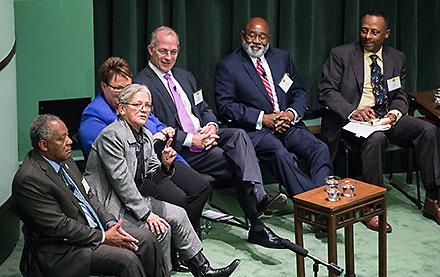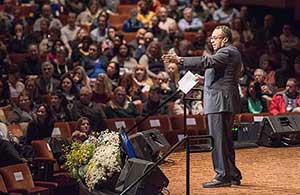Crowdsourcing change
More than two dozen Michigan faculty, staff, and students shared comments and ideas for making U-M more diverse, equitable, and inclusive at a community assembly with President Mark Schlissel in early November.
Pulitzer Prize-winning journalist Clarence Page, who emceed the discussion, said such an event is rare, as diversity is more typically discussed among friends and family, rather than in public.
“What makes race such a vexing topic is that all of our experiences are so different,” Page said.
Getting the University community talking about those differences was the main purpose of this key event in U-M’s weeklong Diversity Summit.
“We need all of you to work with us. We need to crowdsource the solutions to the challenges that we all share in an environment that we all love,” Schlissel said.
The president said his goal for the assembly was to hear many voices, and at the same time get people to listen to one another.
“I heard a lot of honesty, subterranean anger, and discomfort,” Schlissel said near the end of the two-hour gathering at which about 1,000 people nearly filled Rackham Auditorium.
“I heard a lot of ambition, a lot of shared interests in trying to make the University a place we can be increasingly proud of, of people wanting us to live up to our highest ideals.”
http://youtu.be/QtRDhYP7QNg
View the entire Community Assembly on Diversity.
Do you see what I see?
As part of the discussion, Page asked audience members to frame their comments around two questions: What would they like a more diverse, inclusive campus to look like by 2025, and what steps should be taken to achieve those goals? Following are some of those comments:
Jerrica DeLaney, a program coordinator at the Office of Academic Multicultural Initiatives, said she’d like to see “a classroom setting where professors, from adjunct all the way up to tenured, are culturally competent to handle the arrows and darts that are thrown at students of color in their classroom.”
School of Public Health student Jamie Tam said U-M is relying on the good will of campus community members to contribute to diversity work outside of their University jobs. She asked what kind of concrete incentives are being created at U-M to encourage such work, and said that is the way real change will occur.
“I would very much like this place to feel like home,” said Hector Galvan, a 2014 LSA graduate and OAMI project coordinator. He said he loves U-M but that a feeling of “home” wasn’t always the case during his experience as an undergraduate and graduate student. “What’s really worse is I feel like no one cared.”
George Garcia, professor and chair of medicinal chemistry in the College of Pharmacy, said a key phrase that comes to his mind when he envisions the future is the “absence of fear.” He said fear of other people and cultures needs to be reduced, along with the fear of not belonging. “I think if those are gone then we are truly successful.”
Katie Oppenheim, president of the U-M Professional Nurse Council, said the U-M Health System lacked diversity, and that patients respond better to care when it is provided by people like them.
Mary Beth Damm, director of the Center for Engineering Outreach and Engagement, said we live in an incredibly segregated society, and that we need to teach students how to listen, talk to one another, and respectfully discuss issues.
Several members of the activist group By Any Means Necessary also spoke, reiterating the group’s earlier criticism of the University’s efforts to increase minority enrollment.
“I don’t think the problem is that the University doesn’t know how to do it,” said Kate Stenvig, a U-M alumna and BAMN organizer. “I think the problem has been a lack of will.”
http://youtu.be/mGRDphTdY5A
Reflections on U-M’s Diversity History
Beyond race
The discussion also turned to diversity issues outside of race. Patricia Anderson, an emerging-technology informationist at the University Library, suggested a community-campus map be developed to address accessibility issues.
“Where can you find easy access to a bathroom if you’re in a wheelchair? There’s all these different types of access and we don’t have a map to show where can we go to get what it is what we need to make our daily functioning work,” she said.

In a separate event, higher education leaders convened to discuss issues on their respective campuses. From left: James Anderson, chancellor of Fayetteville State University; Nancy Barcelo, president of Northern New Mexico College; Susan Borrego, chancellor of UM-Flint; Jeffrey Docking, president of Adrian College; Willie Larkin, president of Grambling State University; and Earl Lewis, president of the Andrew W. Mellon Foundation. (Image: Austin Thomason, Michigan Photography.)
Jane Vincent, assistive technology manager with Information and Technology Services, said that although she was happy there was live captioning and a sign-language interpreter at the event, she wasn’t thrilled that the event’s program was not available in large print, or that videos shown during the assembly weren’t close-captioned.
Emily Lawsin, a lecturer in women’s studies and American culture, said many members of color have left her department. “The retaining of students and the retaining of faculty and staff of color are equally important,” she said.
Cheryl Mayes, a Plant Operations employee, said that although she recognized the need for numbers that track progress, sometimes the numbers should be “thrown out the window.”
“When I hear that staff in a particular area, department, whatever, is at a quota for minorities, that is a disparaging statement,” she said. “Those types of measurements keep us from being the kind of university that I hear people saying they want to be a part of.”
Demar Lewis, a master’s student in public policy, said everyone needs to be on the same page and that the University hasn’t always “been a place for everybody.”
“And if we’re really going to be successful, we have to be able to trust that everybody is going to come to the table,” he said. “We have to trust that it’s not just going to be 20 percent of the campus driving everything for the entire University.”
“Change requires bold thinking”
“I don’t think we get there by saying we are the leaders and best,” said Martha Jones, Arthur F. Thurnau Professor, professor of history, and Afroamerican and African studies, and adjunct professor of law. U-M is more “middle of the pack,” she said, noting that change requires bold thinking.
Sara Ahbel Rappe, professor of Greek and Latin, said the University should recruit more graduate students of color.
Some in the audience praised the University for success in promoting diversity.
Tina Pryor said it was beautiful to see diversity in the auditorium crowd. She added that she started at U-M in an office position, and was assisted in attaining her job as human resources director in the School of Dentistry because of support in the department.
She suggested U-M could do a better job of hiring diverse staff and faculty. “We should find a way to challenge managers and build into performance plans how are they recruiting a diverse staff,” she said.
Ryan Moody, a CoE graduate student, encouraged a strategy to better engage international students, who she said exist separately from others.
Callie McKee, director of the Office of New Student Programs Educational Theatre, said all great social movements happen with the help of artists, adding students can be engaged to think out of the box to encourage change.
http://youtu.be/Mmfb8WIjcdk
Forging the path from here to there
The challenge of a lifetime
President Schlissel said the challenge moving forward, both as a campus and as a society, “will require everyday acts of commitment.”
The yearlong effort to create a strategic plan calls for unit plans by the end of this academic year, and their amalgamation into a University plan by September 2016, followed by implementation and evaluation through 2021.“I think the challenges we face as a society, not just on campus but all through our society, are going to require each of us to make a continuous and ongoing commitment to change, not be satisfied with incremental steps but realize that the challenges we face will probably take the rest of our lifetimes,” Schlissel said. “But that doesn’t mean that we don’t push as hard as we can every day and every year as well.”
This story originally appeared in The University Record. James Iseler contributed to the content.





Alan Headbloom - MA, 1980
The University would do well to look to national role models in the area of inclusion and equity. This would most definitely include sister school across the state, Grand Valley State University. http://www.gvsu.edu/inclusion/
Reply
Sandra Girard - LSA 1976, UofM School of Law 1981
Inclusion is not just about recruitment and not even just about welcoming diversity. It must include developing a genuine appreciation of what different people bring.
Reply